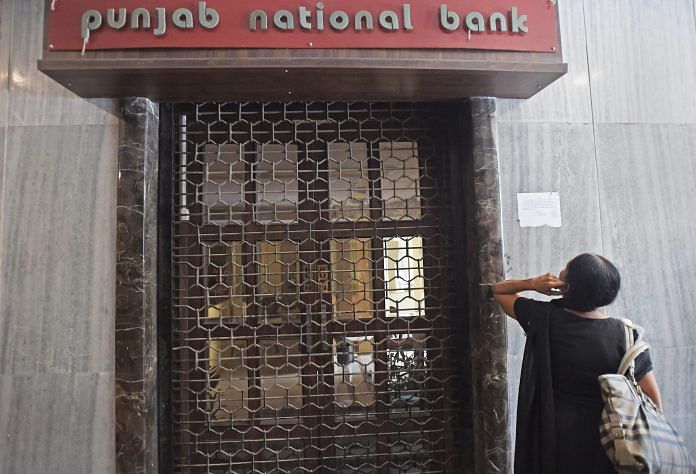The image of Punjab National Bank, whose clientele once included Nehru, Shastri and Indira Gandhi, has taken a major hit with the Nirav Modi fraud.
New Delhi: It takes decades for a financial institution to build a reputation, especially if it is a public sector bank in India. Punjab National Bank (PNB) had sealed that over a century.
But all it took to tarnish its 124-year-old legacy was one single branch and illegal loans amounting to a whopping Rs 11,400 crore it allegedly gave two shady jewellers.
The bank which at one time boasted of serving a distinguished clientele that included Jawaharlal Nehru, Lal Bahadur Shastri and Indira Gandhi, as well as freedom fighters like – Lala Lajpat Rai, Rafi Ahmed Kidwai, Gobind Ballabh Pant, is now facing questions about its trustworthiness.
Created in 1894, PNB was one of the first privately owned Indian banks, and a product of the independence struggle which stood the test of time. It is presently the second largest state-owned bank in the country.
Origin of PNB
Punjab National Bank came into existence on 19 May 1894 and started its operation on 12 April 1895, with an authorised capital of Rs 2 lakh and a working capital of Rs 20,000. Its office was located opposite the Arya Samaj Mandir in Anarkali, Lahore.
After the annexation of Punjab in the 1840s, the country saw the birth of a new class of educated Indians, who wanted a swadeshi bank with Indian money and management.
Raj Mool Raj of the Arya Samaj was particularly unhappy with the fact that Indian capital was being used to run English banks and companies, whereas Indians had to content themselves with low interest on their own capital.
Hence he came up with the idea of Indians owning a national bank, which was then made real by Lala Lajpat Rai and others.
Bulaki Ram Shastri, a lawyer from Lahore, was appointed the first manager of Punjab National Bank.
The banking crisis of 1913
By 1913, there were as many as 451 banking companies in India. However, the failure of Indian Specie Bank and People’s Bank of India led to turbulent times for the banking sector.
Almost 78 banks failed during this crisis, but PNB says it survived because it had better management.
Period of growth and the Partition
The period between 1941 and 1946 saw PNB register extraordinary growth. Its deposits grew from Rs 10 crore to Rs 62 crore, and the number of branches increased from 71 to 278.
Before Independence and the Partition, PNB decided to shift base to Delhi. It had to close down 92 branches in West Pakistan, which constituted 33 per cent of its total branches and held 40 per cent of its deposits.
Period of consolidation
PNB’s deposits grew almost eight times between 1949 and 1969.
In 1951, it took over the assets and liabilities of Bharat Bank Ltd, thus making it the second largest private bank in the country. From a meagre Rs 43 crore in its vaults, PNB’s deposits touched the Rs 350 crore mark during these 20 years.
Bank nationalisation
Between 1947 and 1955, as many as 361 private banks failed. In 1969, Indira Gandhi decided to nationalise banks. This included PNB.
After nationalisation, PNB facilitated credit to priority sectors like agriculture, which it says had largely been ignored by private banks. Its nationwide presence helped the bank sponsor Regional Rural Banks (RRBs) to strengthen the rural credit delivery system.
Period of Liberalisation
As the private sector slowly started entering the Indian banking industry again, the government started divesting its holding in PNB.
By listing the bank on the bourses, the government divested 20 per cent of its holding in the bank. In 2003, it acquired Kerala-based Nedungadi Bank to further increase its presence in South India, making it the seventh merger in PNB’s then 115-year history.
In 2005, the bank reduced its government shareholding to 57.8 per cent and came out with Follow-on Public Offer (FPO) to meet future capital requirements.
“PNB was the first state-owned bank to start Core Banking Solution (CBS). CBS wouldn’t have been there had PNB not been there,” S.S. Kohli, former CMD of PNB, said.
PNB was also one of the first banks which started training colleges for farmers for free, he said.
“Moreover, PNB along with the Bank of India introduced the Voluntary Retirement Scheme in 2000, which led to 12.5 per cent employees moving out of the system without a single strike,” Kohli said.
Present day scenario
As of September 2017, PNB has opened 174.93 lakh accounts.
However, PNB’s Non Performing Assets (NPAs) more than doubled to Rs 55,800 crore in 2016. The bank’s balance sheet also faltered, and PNB reported its highest ever loss of Rs 5,367 crore in a quarter.
Prior to the alleged fraud involving Nirav Modi coming to light, PNB had posted a profit of Rs 230 crore. The bank also showed improvement on the asset quality front as gross NPAs were lower.
However, since the discovery of the fraud, PNB has lost thousands of crores in market valuation. Individuals, and industry bodies like ASSOCHAM, have said the incident highlights the need to privatise state-owned banks.




But this Bank was owned By Sardar Dyal Singh Majithia.Which didn’t mention anywhere.
At that time he was richest man.He gave country Dyal Singh college in Lahore after partition in Karnal & Delhi,The Tribune.Largest news paper of North.